核心、进程与线程
核心、进程与线程
以下内容适用于C/C++,不适用于Python和Java.
Introduction
Program
Program「程序」,一个程序可以创建多个 Process「进程」。
Process
process「进程」
- A process is an instance of a running program「进程是正在运行的程序的实例」
- A program is static, like a cookbook「程序是静态的,就像菜谱一样」
- A process is dynamic, has lifetime, like cooking「一个过程是动态的,有生命,就像烹饪一样」
- Many processes can be started running the same program「可以启动多个进程来运行同一程序」
- Important resources needed by each process「每个进程需重要资源」
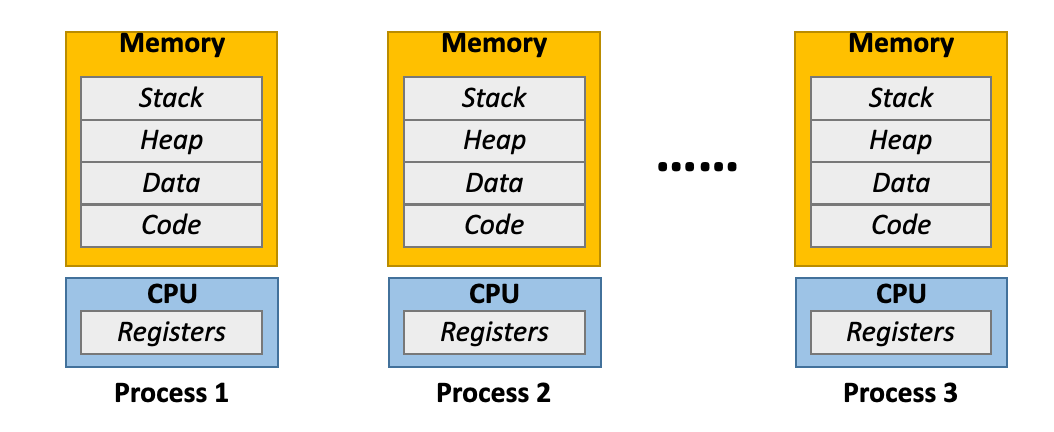
Thread
Thread「线程」,一个Process 可以由调用多个 Thread。
The concept of concurrency
concurrency「并发」
- There are more than one thread, before one running thread finishes, another thread has stared execution「有多个程序,在一个正在运行的程序完成之前,另一个程序已开始执行」
- Multiple programs use the CPU alternatively「多个程序交替使用CPU」
- The operating system offers the capability to shift between threads「操作系统提供了在线程之间切换的功能」
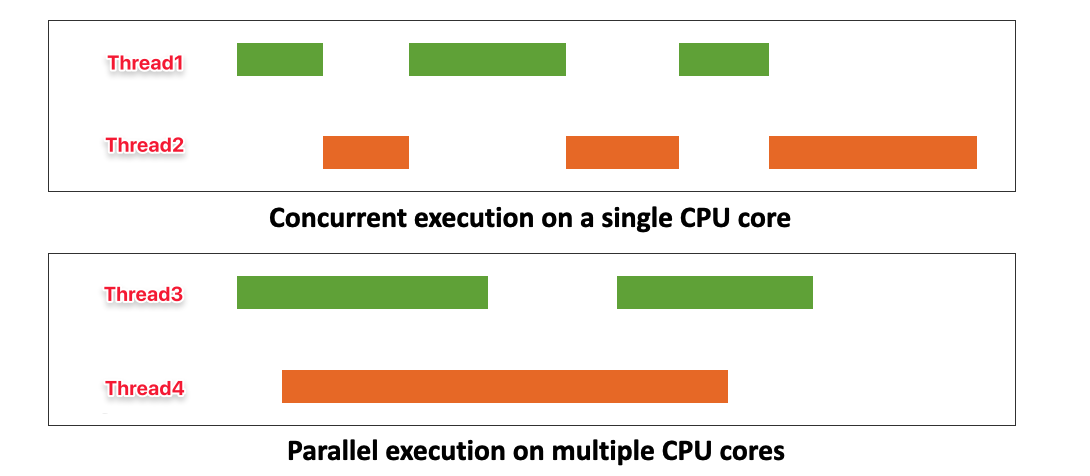
流程图
这里的Processing翻译为流程,但不是进程!它演示的是线程的切换,而不是进程。
- Typical work flow of switching among processings「流程间切换的典型工作流程」
- Start processing A
- Save the context of A (registers) to A’s memory region「将A(寄存器)的上下文保存到A的内存区域」
- Load the context of processing B「加载流程B的上下文」
- Start to execute processing B「开始执行流程B」
……
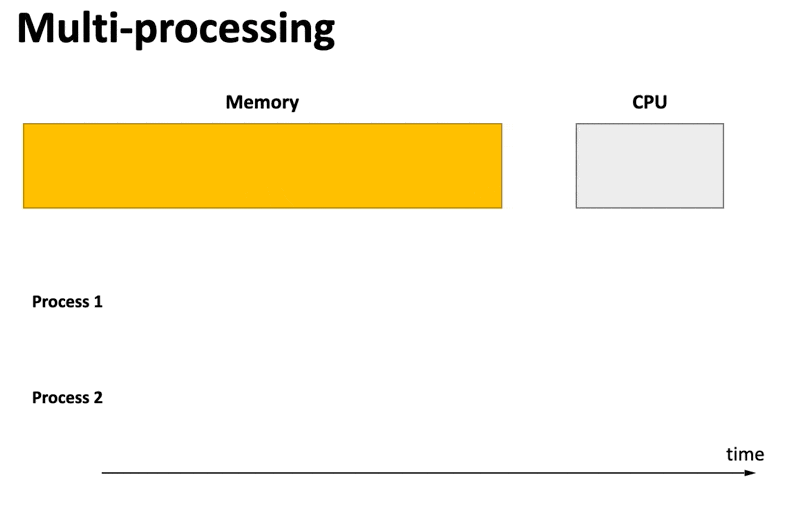
核心「core」和线程「thread」的关系
计算机的CPU核数是同时可以并行的线程数量
- 线程是CPU调度分配的最小单位
- 由于超线程技术,实际上可以并行的线程数量通常是物理核数的两倍
- 我们只关心可以并行的线程数量,所以 以后所说的核数是操作系统看到的核数,所指的核也是超线程技术之后的那个核(不是物理核)
- 操作系统看到的核心数 = 可以并行的线程数量(非物理核心数),所以我们认为 核心数 = 可以并行的线程数量
故,我们可以认为,一个核心只能同时执行一个线程
进程「process」 和 线程 的关系
进程是操作系统资源分配(内存,显卡,磁盘)的最小单位
线程是执行调度(即CPU调度)的最小单位(CPU看到的都是线程而不是进程)
一个进程可以有一个或多个线程
线程之间共享进程的资源,通过这样的范式,就可以减少进程的创建和销毁带来的代价,可以让进程少一点,保持相对稳定,不断去调度线程就好。
并行 和 并发
Concurrent 翻译成 并发
这两个词是对线程而言的。
并行:多个线程同时运行在不同的核心中
并发:多个线程交叉运行在一个核心中
如果计算机有多个CPU核心,线程就可以并行运行在不同的核。
对于每一个核心,多个线程交叉运行,这多个线程可以称之为并发,即为了均衡负载,CPU调度器会不断的在单核上切换不同的线程执行。一个核只能运行一个线程,这是一个暂停一个线程进而启动另一个线程的活动,目的就是不让CPU空闲。
启发
- 并发虽然让我们看起来不同线程之间的任务是并行执行的,但是实际上却由于增加了线程切换的开销使得代价更大了。如果是多核多线程,且线程数量大于核数,其中有些线程就会不断切换,并发执行,但实际上最大的并行数量还是当前这个进程中的核的数量,所以盲目增加线程数不仅不会让你的程序更快,反而会给你的程序增加额外的开销。
- 任务可以分为计算密集型和IO密集型,假设我们现在使用一个进程来完成这个任务,对计算密集型任务,可以使用【核心数】个线程,就可以占满cpu资源,进而可以充分利用cpu,如果再多,就会造成额外的开销;对于IO密集型任务(涉及到网络、磁盘IO的任务都是IO密集型任务),线程由于被IO阻塞,如果仍然用【核心数】个线程,cpu是跑不满的,于是可以使用更多个线程来提高cpu使用率。
- 实现并行计算有三种方式,多线程,多进程,多进程+多线程
- 如果是多进程,因为每个进程资源是独立的(地址空间和数据空间),就要在操作系统层面进行通信,如管道,队列,信号等;多线程的话会共享进程中的地址空间和数据空间,一个线程的数据可以直接提供给其他线程使用,但方便的同时会造成变量值的混乱,所以要通过线程锁来限制线程的执行
- 其他语言,CPU 是多核时是支持多个线程同时执行。但在 Python 中,无论是单核还是多核,一个进程同时只能由一个线程在执行。其根源是 GIL 的存在。GIL 的全称是 Global Interpreter Lock(全局解释器锁),来源是 Python 设计之初的考虑,为了数据安全所做的决定。某个线程想要执行,必须先拿到 GIL,我们可以把 GIL 看作是“通行证”,并且在一个 Python 进程中,GIL 只有一个。拿不到通行证的线程,就不允许进入 CPU 执行。所以多线程在python中很鸡肋。
Miti-Process
Miti-Process 「多进程」
Programs so far
When a program runs
- It totally occupies the CPU
- It consumes memory
- It will not stop until the last instruction is finished
- The program now runs in an isolated world「该程序现在在一个孤立的世界中运行」
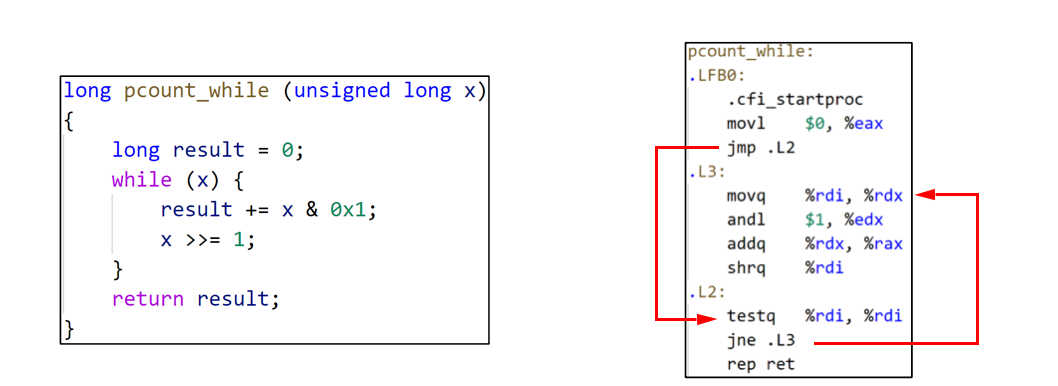
USERS: I want to run multiple programs at the same time「用户:我想同时运行多个程序」
COMPUTER DESIGNERS: I want the hardware to be used more efficiently「计算机设计师:我希望硬件得到更有效的利用」
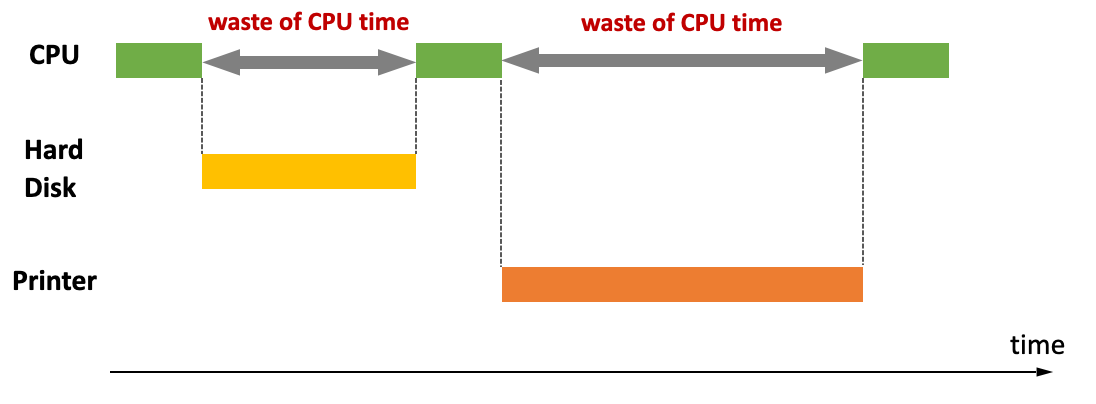
Fork()
Introduction
fork 应用于 Unix,可以在 MacOS或Linux 进行实验。
一个进程,包括代码、数据和分配给进程的资源。
fork()函数通过系统调用创建一个与原来进程几乎完全相同的进程,也就是两个进程可以做完全相同的事,但如果初始参数或者传入的变量不同,两个进程也可以做不同的事。
一个进程调用fork()函数后,系统先给新的进程分配资源,例如存储数据和代码的空间。然后把原来的进程的所有值都复制到新的新进程中,只有少数值与原来的进程的值不同。相当于克隆了一个自己。
遇到fork()后,它把进程当前的情况拷贝一份!
#include <unistd.h>
#include <stdio.h>
int main ()
{
pid_t fpid; //fpid表示fork函数返回的值
int count=0;
fpid=fork();
if (fpid < 0)
printf("error in fork!");
else if (fpid == 0) {
printf("i am the child process, my process id is %d/n",getpid());
count++;
}
else {
printf("i am the parent process, my process id is %d/n",getpid());
count++;
}
printf("统计结果是: %d/n",count);
return 0;
}
运行结果
i am the child process, my process id is 5574
统计结果是: 1
i am the parent process, my process id is 5573
统计结果是: 1
在语句fpid=fork()之前,只有一个进程在执行这段代码,但在这条语句的同时(包含这条语句),就变成两个进程在执行了,这两个进程的几乎完全相同,将要执行的下一条语句都是if(fpid<0)……
为什么两个进程的fpid不同呢,这与fork函数的特性有关。
fork调用的一个奇妙之处就是它仅仅被调用一次,却能够返回两次,它可能有三种不同的返回值:
- 在父进程中,fork() 返回新创建子进程的进程ID;
- 在子进程中,fork() 返回0;
- 如果出现错误,fork() 返回一个负值;
父进程与子进程
在fork函数执行完毕后,如果创建新进程成功,**则出现两个进程,一个是子进程,一个是父进程。**在子进程中,fork函数返回0,在父进程中,fork返回新创建子进程的进程ID。我们可以通过fork返回的值来判断当前进程是子进程还是父进程。
相对父进程和相对子进程
当一个子进程创建了新的子进程,那么这个新的子进程相对于创建它的子进程就是相对子进程,创建这个子进程的进程叫相对父进程,相对父进程和相对子进程具有父子进程应该具有的属性。
比如子进程里创建的相对子进程返回的pid就是0,但是子进程里相对父进程就返回真实的pid。
同样的,相对父进程的waitpid()将会等待相对子进程的结束。
流程
- 使用 fork()
- 在此处创建一个新的进程
- 复制当前已经有的变量到洗呢进程里面
- 父子进程同时运行
有时候,fork会copy整个语句,比如在if语句里。
怎样理解?
只需记住不是从#include处开始复制代码的,而是遇到fork()后,把进程当前的情况拷贝一份!
fork() 出错原因
使用fork() 创建的进程都是子进程。
- 当前的进程数已经达到了系统规定的上限,这时errno的值被设置为EAGAIN。
- 系统内存不足,这时errno的值被设置为ENOMEM。
父子进程的顺序
创建新进程成功后,系统中出现两个基本完全相同的进程,这两个进程执行没有固定的先后顺序,哪个进程先执行要看系统的进程调度策略。
每个进程都有一个独特(互不相同)的进程标识符(process ID)。
在子进程里,可以通过 getpid()函数获得,通过getppid()函数获得父进程 pid。
Write a Muti-Process program
Write a program
- a process A is created and started with the program;
- when A runs, A creates a new process B, running the same program as A, and concurrently with A
「编写程序:创建进程A,并从该程序启动;当A运行时,A创建一个新进程B,与A运行相同的程序,并与A同时运行」
A: parent process「父进程」; B: child process「子进程」

注意:在子进程中使用pid = fork(),得到的pid是0,但是子进程真正的pid中并不是0。
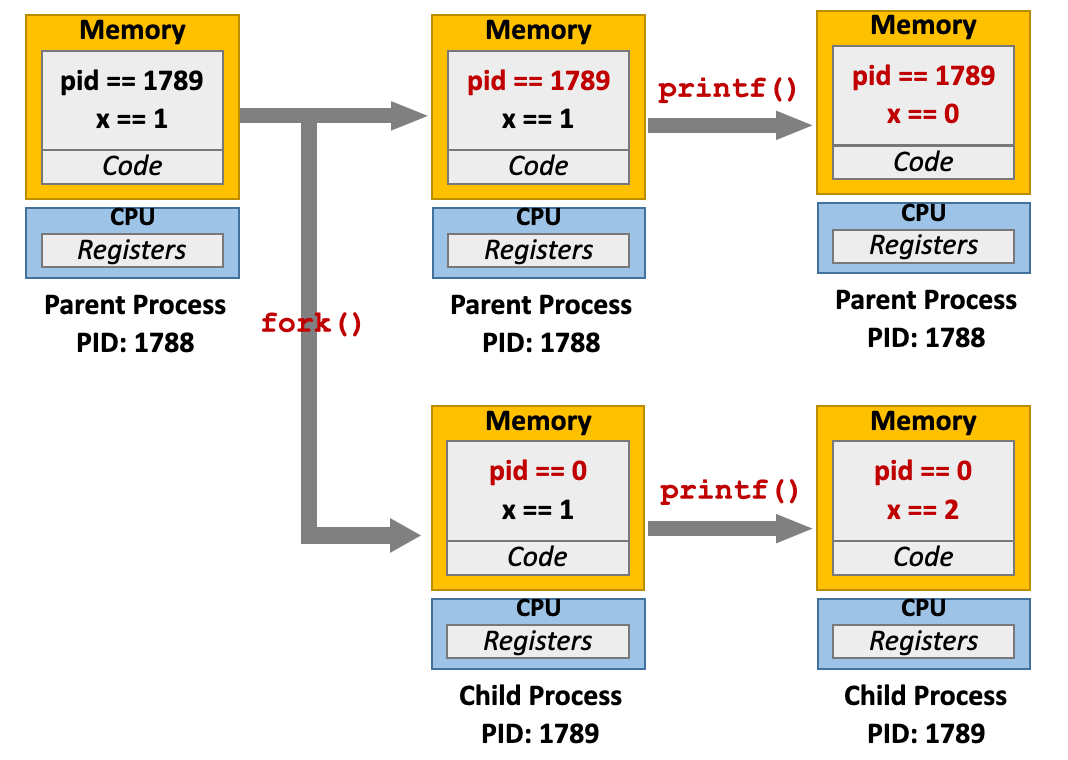
Modeling with process graph
Modeling with process graph「使用过程图建模」
- A process graph is a tool for capturing the partial ordering of statements in a concurrent program「流程图是用于捕获并发程序中语句的部分排序的工具」
- Each vertex is the execution of a statement「每个顶点都是一条语句的执行」
- a -> b means a happens before b「A-> b表示a在b之前发生」
- Edges can be labeled with current value of variables「边缘可以用变量的当前值标记」
- printf vertices can be labeled with its output「printf顶点可以用其输出标记」
- Each graph begins with a vertex with no in-edges「printf顶点可以用其输出标记」

Example
How many “Example” output lines does this program print?
void try()
{
fork();
printf("Example\n");
fork();
return;
}
int main()
{
try();
fork();
printf("Example\n");
exit(0);
}
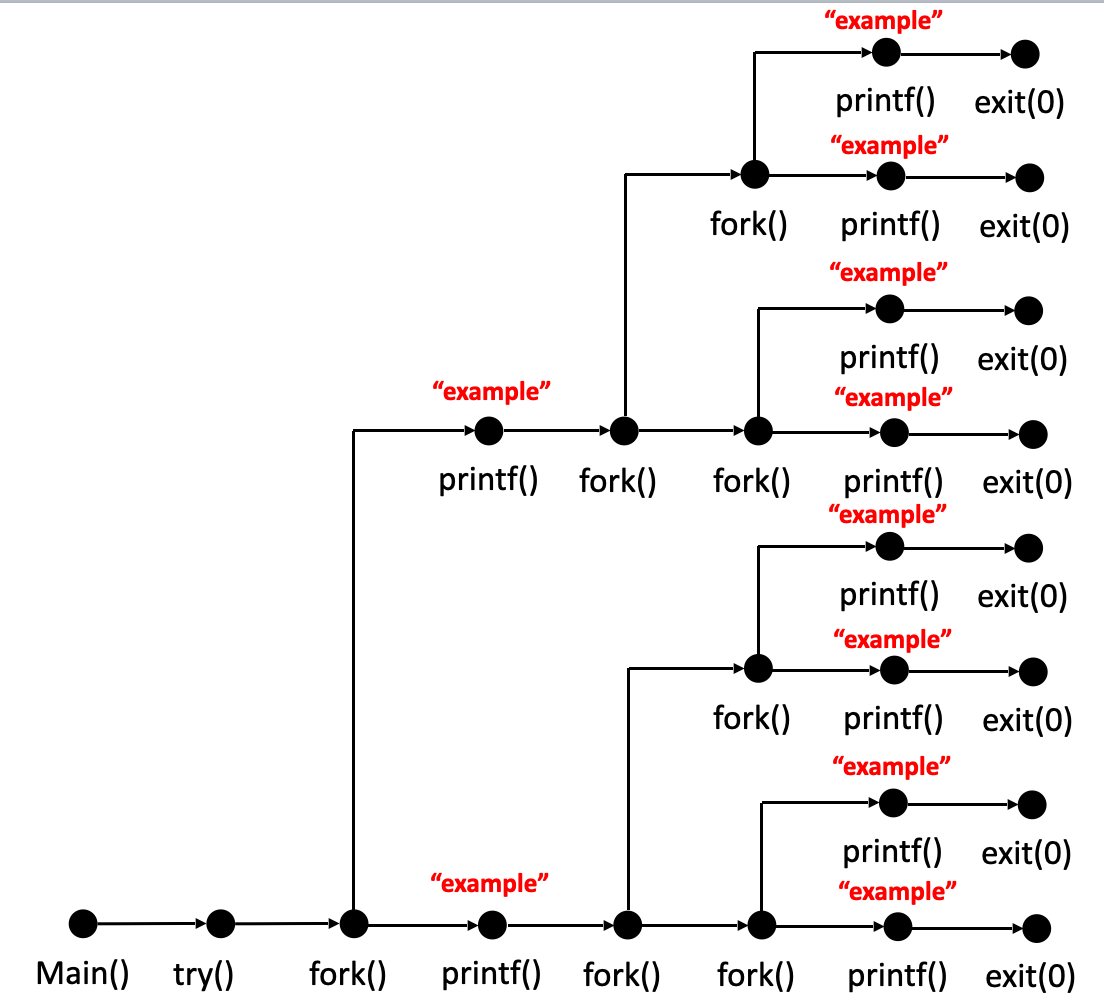
Synchronizing parent with child
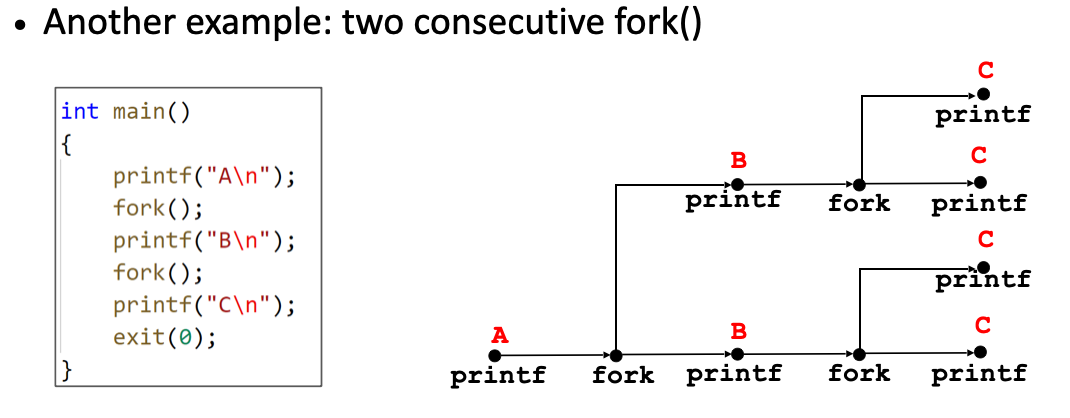
Is the following outputs valid? Why?
- ACBCBCC
- ABCCBCC
- ABCBCCC
The wait() function
wait(int* status);
wait() 会暂时停止目前进程的执行, 直到有信号来到 或 任一子进程结束
作用
- Suspend current process until one of its children terminates「暂停当前过程,直到其子进程之一终止」
- Return value is the pid of the child process that terminates「返回值是终止的子进程的pid」
返回值
- 如果在调用wait() 时子进程已经结束, 则wait()会立即返回子进程结束状态值.
- 如果在调用wait() 时子进程还没有结束, 则wait()会等待任何一个子进程结束,之后立刻返回子进程结束状态值.
参数设置
int* status
这个参数将保存子进程的状态信息,有了这个信息父进程就可以了解子进程为什么会推出,是正常推出还是出了什么错误。如果status不是空指针,则状态信息将被写入指针指向的内存。当然,如果不关心子进程为什么推出的话,也可以传入将status设置为空指针,即nullptr .
- status: If status != nullptr, the integer it points to will be set to a value that indicates the reason why the child terminates「child _ status:如果 status!= nullptr,则它指向的整数将设置为一个值,该值指示子级终止的原因」
- Use macros「宏」 to extract the information given by status
waitpid()
#include <sys/types.h>
#include <sys/wait.h>
pid_t waitpid(pid_t pid,int *status,int options);
对于父进程而言
- 如果在调用waitpid()函数时,当指定等待的子进程已经停止运行或结束了,则waitpid()会立即返回;
- 如果子进程还没有停止运行或结束,则调用waitpid()函数的进程则被阻暂停运行,直到指定的进程停止运行并返回退出码后。
- 如果waitpid()函数执行成功,则返回子进程的进程号;
- 如果有错误发生,则返回-1,并且将失败的原因存放在errno变量中。
- 失败的原因主要有
- 没有子进程(errno设置为ECHILD)
- 调用被某个信号中断(errno设置为EINTR)
- 选项参数无效(errno设置为EINVAL)
子进程碰到waitpid()直接跳过。但相对父进程会等待相对子进程。
参数设置
pid_t pid
参数pid为欲等待的子进程识别码,其具体含义如下:
| 参数值 | 说明 |
|---|---|
| pid<-1 | 等待进程组号为pid绝对值的任何子进程。 |
| pid=-1 | 等待任何子进程,此时的waitpid()函数就退化成了普通的wait()函数。 |
| pid=0 | 等待进程组号与目前进程相同的任何子进程,也就是说任何和调用waitpid()函数的进程在同一个进程组的进程。 |
| pid>0 | 等待进程号为pid的子进程。 |
所以可以说,waitpid() 和 wait() 函数一个不同的地方就在 waitpid() 支持指定的进程号。
这些参数可以用“|”运算符连接起来使用。
int options
参数options提供了一些另外的选项来控制waitpid()函数的行为。如果不想使用这些选项,则可以把这个参数设为0。
主要使用的有以下两个选项:
| 参数 | 说明 |
|---|---|
| WNOHANG | 如果pid指定的子进程没有结束,则waitpid()函数立即返回0,而不是阻塞在这个函数上等待;如果结束了,则返回该子进程的进程号。 |
| WUNTRACED | 如果子进程进入暂停状态,则马上返回值。 |
如果像这样调用waitpid函数:waitpid(-1, status, 0),这此时waitpid()函数就完全退化成了wait()函数。
MACROS
MACROS「宏」
| MACROS | Indication |
|---|---|
| WIFEXITED(status) | Returns true if the child terminated normally, via a call to exit or a return.「如果子进程正常结束,它就返回真;否则返回假。」 |
| WEXITSTATUS(status) | Returns the exit status of a normally terminated child. This status is only defined if WIFEXITED() returned true.「如果WIFEXITED(status)为真,则可以用该宏取得子进程exit()返回的结束代码。」 |
| WIFSIGNALED(status) | Returns true if the child process terminated because of a signal that was not caught.「如果子进程因为一个未捕获的信号而终止,它就返回真;否则返回假。」 |
| WTERMSIG(status) | Returns the number of the signal that caused the child process to terminate. This status is only defined if WIFSIGNALED() returned true.「如果WIFSIGNALED(status)为真,则可以用该宏获得导致子进程终止的信号代码。」 |
| WIFSTOPPED(status) | Returns true if the child that caused the return is currently stopped.「如果当前子进程被暂停了,则返回真;否则返回假。」 |
| WSTOPSIG(status) | Returns the number of the signal that caused the child to stop. This status is only defined if WIFSTOPPED() returned true.「如果WIFSTOPPED(status)为真,则可以使用该宏获得导致子进程暂停的信号代码。」 |
| WIFCONTINUED(status) | Returns true if the child process was restarted by receipt of a SIGCONT signal.「如果子进程通过接收到SIGCONT信号而重新启动,则返回true。」 |
Example
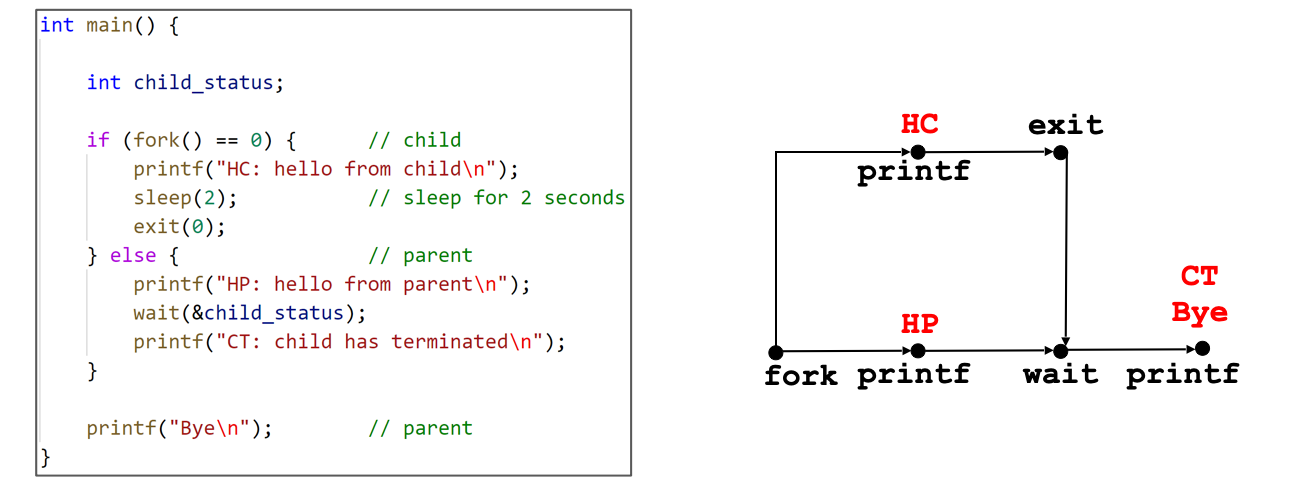
- HC -> HP -> CT -> bye
- HP -> HC -> CT -> bye
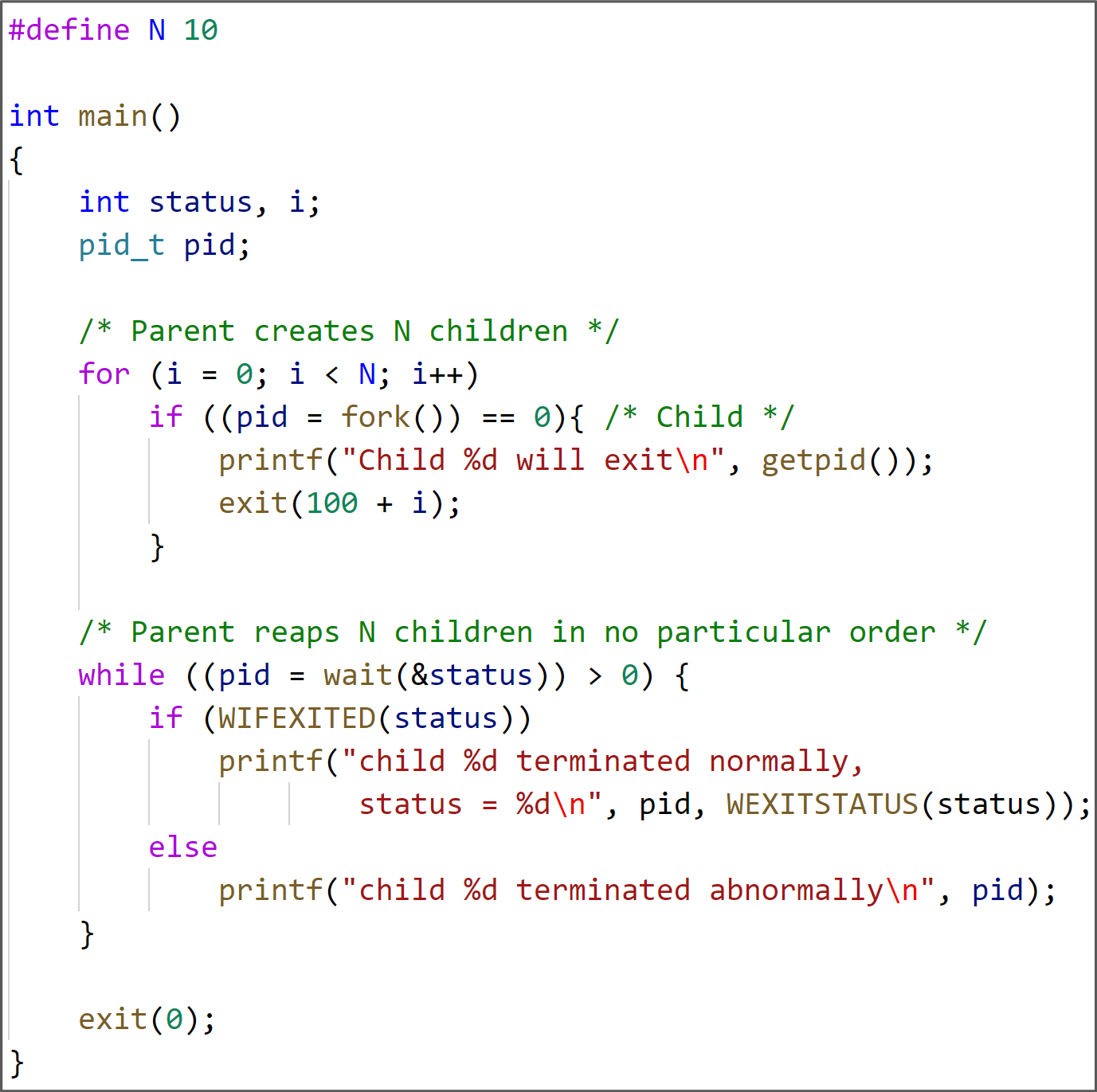
Signals
- An OS mechanism to allow one process interrupt another process. 「一种允许一个进程中断另一进程的OS机制。」
- A signal is a small message that notifies a process that an event of some type has occurred in the system「信号是一条小消息,用于通知进程系统中发生了某种类型的事件」
- A signal receiver can respond according to the signal occured「信号接收器可以根据发生的信号做出响应」
kill
- With command, e.g., kill
- Let the child process enter an infinite loop
- Use the command “kill” to terminate the child process
- With command, e.g., kill
- Let the child process enter an infinite loop「让子进程进入无限循环」
- Use the command “kill” to terminate the child process「使用命令“ kill”终止子进程」
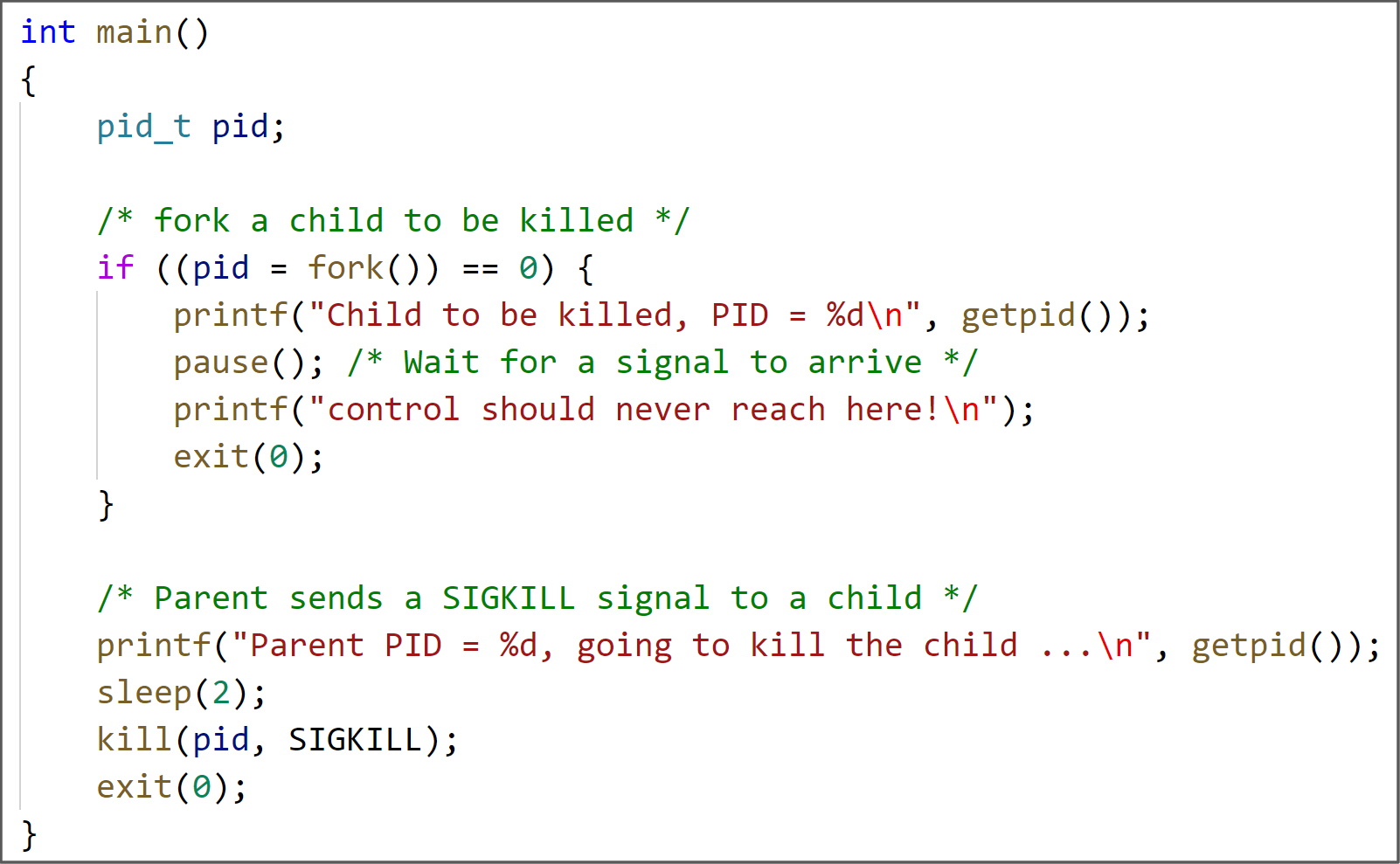
Receiving a signal
We let the process to listen to signal SIGINT「我们让进程监听信号SIGINT」
SIGINT = Ctrl-C
- The process will wait by calling pause()「该过程将通过调用pause()等待」
- When the user press Ctrl-C, a signal handler will be executed「当用户按下Ctrl-C时,将执行信号处理程序」
Interrupts
- A CPU provides hardware signals, called interrupts, to represent that something happens「CPU提供称为中断的硬件信号,以表示发生了某些事情」
- For example, pressing Ctrl+C will generate an interrupt「例如,按Ctrl + C将产生一个中断」
- Programs will be developed to handle different interrupts, called interrupt handlers「将开发用于处理不同中断的程序,称为中断处理程序」
- At the end of each instruction cycle, the CPU will check if any interrupt has come「在每个指令周期结束时,CPU将检查是否有任何中断发生」
- Fetch -> decode -> execute -> check interrupt
- If an interrupt occurs, the corresponding interrupt handler will be called to perform specified functionality「如果发生中断,则将调用相应的中断处理程序以执行指定的功能」
Steps to process a signal
- In modern computer systems, interrupts will be received and managed by the operating system「在现代计算机系统中,中断将由操作系统接收和管理」
- Using signal() to register interrupt handler
- OS will transfer the control to application process to execute interrupt handler「操作系统将控制权转移到应用程序进程以执行中断处理程序」
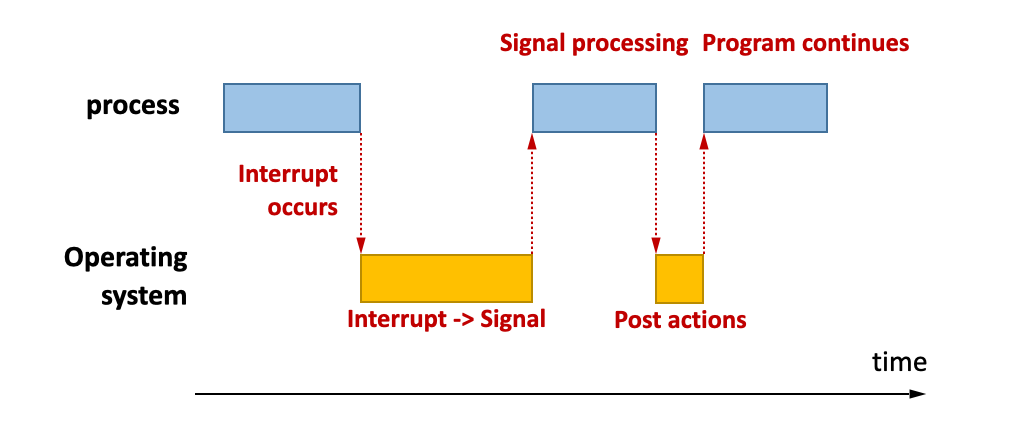
Issues not covered so far
「到目前为止未涵盖的问题」
- How each switching is triggered? 「如何触发每个切换?」(interrupts, will explain soon)
- Who is managing the switching? 「谁在管理交换?」(an operating system)
- When thread A pauses, there are B, C, D, …, which one should I switch to? (thread scheduling, to learn in OS courses)「当线程A暂停时,有B,C,D,...,我应该切换到哪一个?
引用
- https://zhuanlan.zhihu.com/p/82123111
- https://blog.csdn.net/jason314/article/details/5640969
- https://blog.csdn.net/cuit2016123070/article/details/83280125
- https://blog.csdn.net/Roland_Sun/article/details/32084825
Java
对于Java,只考虑并行和多线程。通常的,Java使用多线程(Muti-Thread) 编程,而不是多进程(Muti-Process)